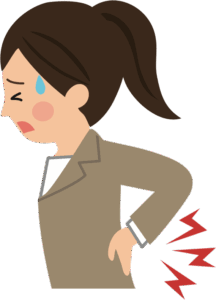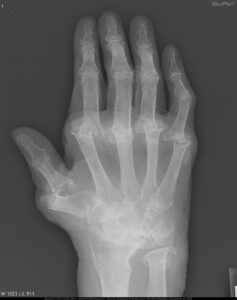Joint pain that is severe and disabling may indicate the need for surgery to replace the old worn out joint. It is often caused by osteoarthritis. Total joint replacements can help patients regain mobility, strength and daily activities but is often used as a last resort when pain medications, weight loss, and exercise is not enough. PT can help patients with total joint replacements rehabilitate and regain mobility, strength and function. Common joint replacements are knee and hip, less common are shoulder, ankles, wrist and elbows.
Archives: Conditions
Holds our conditions and condition-specific data
Myofascial pain syndrome
Myofasical pain syndrome refers to pain and inflammation in the body’s soft tissue. This may be a chronic condition that affects the fascia or connective tissue of muscles. It may involve one muscle or a muscle group. Pain may also be referred from the actual site of injury through a trigger point causing pain in other areas. Myofasical pain can develop from an injury or strain to a muscle, ligament, or tendon. Physical therapy can help by decreasing pain through use of myofascial release and/or soft tissue mobilization which may help decrease myofascial tension, exercises to help strengthen and/or stretch weakened and tight areas and education in stress management, posture and ergonomics to help prevent re-occurrence.
Weight Loss
 Weight loss is a reduction of total body weight. Unintentional weight loss may indicate diabetes mellitus, nutrition changes, and fluid loss. Intentional weight loss may be in response to an effort to improve overall fitness and health and has many benefits including decreased risk for Type 2 diabetes, heart disease, high blood pressure and osteoporosis. Working with a licensed physical therapist can be an asset in achieving your weight loss goals as we are trained to help identify your main problems, design an individualized exercise program and will address the whole person to help guide you to a safe and effective program to achieve weight loss and better health.
Weight loss is a reduction of total body weight. Unintentional weight loss may indicate diabetes mellitus, nutrition changes, and fluid loss. Intentional weight loss may be in response to an effort to improve overall fitness and health and has many benefits including decreased risk for Type 2 diabetes, heart disease, high blood pressure and osteoporosis. Working with a licensed physical therapist can be an asset in achieving your weight loss goals as we are trained to help identify your main problems, design an individualized exercise program and will address the whole person to help guide you to a safe and effective program to achieve weight loss and better health.
Neuro Physical Therapy
Neuromuscular re-education is a technique used in therapy to help improve balance, coordination, posture and body awareness. Balance and postural stability exercises may be used and the patient is encouraged to feel the correct position of joints and where the extremity is in space.
Weakness
Weakness is decreased strength in one or more muscles. Weakness may be total body or local to a specific body part or muscle. You may feel weak with having mono or the flu. Weakness may also be due to metabolic reasons (low sodium/potassium, hypothyroidism), neurologic (stroke, bells palsy, cerebral palsy, multiple sclerosis), toxic (botulism, shellfish poisoning), and primary musculature diseases (muscular dystrophy). After a thorough evaluation, physical therapy may include instruction in exercises to help strengthen weak areas, education in posture to decrease stress to joints and muscles and manual therapy if needed for alignment and alleviate tight muscles.
Muscle Spasms
Muscle spasms, also known as muscle cramps, are involuntary and painful contractions that may be alleviated by stretching the muscle. Muscle spasms can be caused by a variety of reasons including muscle fatigue, heavy exercises, pregnancy, dehydration, reduced levels of magnesium and calcium in the body, medications, and hypothyroidism. Physical therapy can help by providing a thorough evaluation and a treatment program which may include exercises to help strengthen and stretch the area, manual therapy to help release tight structures and education for posture and/or diet tips if applicable.
Headaches
 Headaches can be caused by many things. After identifying the problems that may be contributing to your headache, we will design a specific program to address your needs. This program may include education in posture and ergonomics, manual therapy, exercises for stretching, strengthening and modalities.
Headaches can be caused by many things. After identifying the problems that may be contributing to your headache, we will design a specific program to address your needs. This program may include education in posture and ergonomics, manual therapy, exercises for stretching, strengthening and modalities.
Back Pain
 Back pain can be found in the low, mid, and upper regions of the back and can be caused by a wide variety of activities and or injuries. Symptoms are usually pain with motion or transitional movements and are very limiting. Pain can be caused by muscle spasms, alignment issues, muscle strain/sprain, or overuse. It is important to address back pain with a full program of strengthening, stretching, stability exercise, alignment work, education in body mechanics and joint protection, and safety all provided by a Goodell PT.
Back pain can be found in the low, mid, and upper regions of the back and can be caused by a wide variety of activities and or injuries. Symptoms are usually pain with motion or transitional movements and are very limiting. Pain can be caused by muscle spasms, alignment issues, muscle strain/sprain, or overuse. It is important to address back pain with a full program of strengthening, stretching, stability exercise, alignment work, education in body mechanics and joint protection, and safety all provided by a Goodell PT.
Arthritis
 Arthritis is joint inflammation caused when the cartilage on joint surfaces gets worn down. It causes pain, swelling, noisy crackling or grating sounds in the joint with movement, stiffness, loss of motion and weakness at joints. Symptoms usually increase with prolonged positions, over use, or repetitive motions. The most common type is osteoarthritis (OA), which occurs as we age and is considered to be a degenerative joint disease. PT can help to support affected joints by strengthening surrounding muscles, maintaining range of motion, and relieving pain and muscle spasm. Regular safe exercise is very important for controlling OA. PT’s here at Goodell PT are trained to develop safe and effective exercise programs tailored specifically to the joints that are painful.
Arthritis is joint inflammation caused when the cartilage on joint surfaces gets worn down. It causes pain, swelling, noisy crackling or grating sounds in the joint with movement, stiffness, loss of motion and weakness at joints. Symptoms usually increase with prolonged positions, over use, or repetitive motions. The most common type is osteoarthritis (OA), which occurs as we age and is considered to be a degenerative joint disease. PT can help to support affected joints by strengthening surrounding muscles, maintaining range of motion, and relieving pain and muscle spasm. Regular safe exercise is very important for controlling OA. PT’s here at Goodell PT are trained to develop safe and effective exercise programs tailored specifically to the joints that are painful.
Chronic Pain
 Pain that has lasted longer then expected for your injuries healing time can be categorized as chronic. Chronic pain can be devastating and interfere with all aspects of your life. Exercise is a very important part of dealing with chronic pain, but it is equally as important to do it properly and within your bodies tolerance and abilities. Patients that suffer from chronic pain have great success with a properly planned exercise program that is carefully observed and monitored by a physical therapist.
Pain that has lasted longer then expected for your injuries healing time can be categorized as chronic. Chronic pain can be devastating and interfere with all aspects of your life. Exercise is a very important part of dealing with chronic pain, but it is equally as important to do it properly and within your bodies tolerance and abilities. Patients that suffer from chronic pain have great success with a properly planned exercise program that is carefully observed and monitored by a physical therapist.
